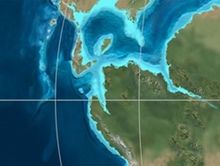Trincheras Formation
| Trincheras Formation Stratigraphic range: Early Aptian ~120–115 Ma |
|
|---|---|
| Type | Geological formation |
| Unit of | Villeta Group |
| Sub-units | Anapoima Mb., El Tigre Mb. |
| Underlies | Socotá Fm., El Peñón Fm. |
| Overlies | Murca Fm., La Naveta Fm., Útica Fm. |
| Thickness | up to 1,260 m (4,130 ft) |
| Lithology | |
| Primary | Shale |
| Other | Sandstone, limestone |
| Location | |
| Coordinates | 4°30′13″N 74°36′22″W / 4.50361°N 74.60611°WCoordinates: 4°30′13″N 74°36′22″W / 4.50361°N 74.60611°W |
| Region |
Altiplano Cundiboyacense Eastern Ranges, Andes |
| Country |
|
| Type section | |
| Named for | Quebrada Trincheras |
| Named by | Cáceres & Etayo |
| Location | Apulo |
| Year defined | 1969 |
| Coordinates | 4°30′13″N 74°36′22″W / 4.50361°N 74.60611°W |
| Region | Cundinamarca |
| Country |
|
 Paleogeography of Northern South America 120 Ma, by Ron Blakey |
|
The Trincheras Formation (Spanish: Formación Trincheras, Kitr) is a geological formation of the Altiplano Cundiboyacense, Eastern Ranges of the Colombian Andes. The formation consisting of a lower unit of calcareous shales and an upper sequence of shales dates to the Early Cretaceous period; Early Aptian epoch and has a maximum thickness of 1,260 metres (4,130 ft). The formation, deposited in a marine platform environment, part of a transgressive cycle, hosts ammonite, bryozoan, mollusc and echinoid fossils.
The formation was defined and named in 1969 by Cáceres and Etayo after Quebrada Trincheras, Apulo, Cundinamarca.
The Trincheras Formation has a maximum thickness of 1,260 metres (4,130 ft), and is characterised by a sequence of claystones with intercalated limestones and sandstones. Fossils of the ammonites Heinzia sp., Pseudohaploceras sp., Heminautilus etheringtoni, Cheloniceras sp. and bryozoans, molluscs and echinoids have been found in the Trincheras Formation.
...
Wikipedia
